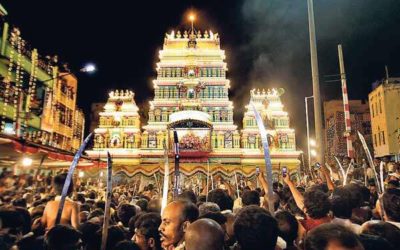The greatest pilgrimage center for Sri Vaishnavites (followers of Lord Vishnu) is the island temple town of Srirangam (Thiruvarangam in Tamil) in the city of Tiruchirappalli in South India. Vishnu is one of the triumvirates or Trimurti in Hinduism, namely Brahma, Vishnu and Shiva. Srirangam is bound by river Cauvery on one side, and the Cauvery tributary Kollidam or Coleroon on the other.
Srirangam’s most famous landmark is the Sri Ranganathaswamy Temple where Vishnu is well-known in the reclining form. It is the largest functioning ancient Hindu temple in the world, covering an area of about 631,000 square metres (6,790,000 sq ft) with a perimeter of 4 km (10,710 ft). It is among a few “self-manifested” shrines (Swayam Vyakta Kshetras) of Lord Vishnu.
Gloriously Ancient
The temple is mentioned in the famous Tamil works of literature of the Sangam Era (3rd century BC to 4th century CE) including in the well known epic Silappadikaram (book 11, lines 35–40). It is glorified in the early medieval Tamil canon Thiviya Pirabancham of the Alvar saints dated to the 6th to the 9th centuries CE.
The Sri Ranganathaswamy temple is counted among the 108 Divya Desams or premium places of worship dedicated to Vishnu. The temple follows the Thenkalai tradition of worship. Thenkalai are a sub-sect of the Sri Vaishnava Iyengar community who are followers of Ramanuja, Manavala Mamuni and Lokacharya.
Temple Complex
The temple complex is 156 acres (0.63 square kilometer) in extent. It has seven concentric walled sections or prakaras which run round the sanctum. There are 21 magnificent towers or gopurams in all, the tallest of which, Rajagopuram, over the sanctum is 236 feet (72 m) tall, and is the tallest in Asia. In ancient historic times the people of the city lived within the walls of this temple, which was quite typical of temples of the times.
The Srirangam Ranganathaswamy temple or Antya Ranga, is one of the three temples of the God Ranganatha that are situated in the natural islands formed in the Cauvery river. The others are the Adi Ranga or the Ranganathaswamy temple at Srirangapatnam and Madhya Ranga or the Ranganathaswamy temple at Shivanasamudra.
The Legend
In the epic of Ramayana, Lord Rama performed a aradhanam or pooja to this reclining idol of Vishnu. As a symbol of love he gifted the idol to Vibhishana the brother of Ravana, to take back with him to Lanka. Rama put forth a condition that the idol should not be set on the ground, failing which the deity would seat Himself permanently there. Vibhishana took this idol and while traveling towards Sri Lanka, came upon the banks of the Cauvery where an utsavam or festival was in progress. Vibhishana placed the idol on the ground to watch the utsavam. When the utsavam was over, Lord Vishnu refused to move as he came to love the place (Srirangam) so much. When Vibhishana requested Vishnu to come with him, He refused but promised to bless Vibhishana by always facing south, in the direction of Sri Lanka. Hence the magnificent reclining Ranganathaswamy is seen facing south within this temple. The Chola kings Dharmavarlochan and Kilivalavan developed the shrine into the big temple it is now.
Loot and Plunder
The richness and magnificence of the Ranganathaswamy temple did not escape notice of the marauding invader Ala-ud-din Khilji whose general Malik Kafur plundered and looted this temple, during his invasion of the Deccan in 14th century CE. Other famouns temples plundered during Malik Kafur’s three campaigns in the Deccan included the famous Madurai Meenakshi temple and the Hoysaleshwara temple at Halebeedu in Karnataka state.
Thriving Temple Tourism Economy
Due to the famous temple, Srirangam has a thriving economy based on tourism. The number of devotees to the town increases greatly during the festival of Vaikuntha Ekadashi which falls in the Tamil month of Margazhi (Margashirsha).
There are many other famous temples near Srirangam. They include the Rockfort temple, Samayapura Mariamman temple, Thiruvanaikoil, Vayalur Murugan temple, Uraiyur Kekkali Amman temple, etc. There are more temples around Srirangam and Tiruchirapalli, along the banks of the Cauvery, most showing Lord Vishnu in the reclining form. These include the Sri Vadivazhagiya Nambi Perumal temple whose deity is known as Appala Ranganathar at Koviladi. Another is Azhagiya Nambi Temple at Woraiyur in Tiruchirappalli which is part of the Sri Ranganathaswamy temple at Srirangam.
References:
https://en.wikipedia.org/wiki/Srirangam
https://en.wikipedia.org/wiki/Ranganathaswamy_Temple,_Srirangam



0 Comments